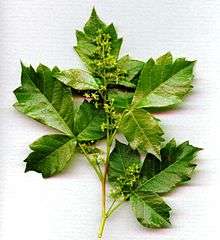Rhus dentata
| Rhus dentata | |
|---|---|
 | |
| Scientific classification | |
| Kingdom: | Plantae |
| (unranked): | Angiosperms |
| (unranked): | Eudicots |
| (unranked): | Rosids |
| Order: | Sapindales |
| Family: | Anacardiaceae |
| Genus: | Rhus |
| Species: | R. dentata |
| Binomial name | |
| Rhus dentata Thunb. | |
Rhus dentata, the nana-berry (English), or nanabessie (Afrikaans), is a medium sized, deciduous tree, reaching a height of about 5 metres and a spread of 4 metres, and with a tendency to scramble through and over neighbouring trees. It occurs naturally in almost the whole of South Africa except the Western and Northern Cape Provinces. Its habitat varies from sea level to the highlands of the Drakensberg. It is frost-hardy and should be planted in full sun. The strongly aromatic leaves are usually conspicuously toothed (hence the name dentata), though sometimes they may be only slightly toothed. The tree produces small, creamy-white flowers in masses, developing into small, flattened drupes (5-6mm) which turn red or orange when ripe and brown when dry. The ripe fruits are eaten by birds, while the foliage is food for the larvae of the pepper tree moth Bombycomorpha bifascia.


Further reading
Titshall, L.W.; O'Connor, T.G.; Morris, C.D. (12 Nov 2009). "Effect of long-term exclusion of fire and herbivory on the soils and vegetation of sour grassland". African Journal of Range and Forage Science. 17 (1-3): 70–80. doi:10.2989/10220110009485742. Retrieved 30 April 2015.
- "Searsia dentata". Plantz Afrika. Retrieved 2010-01-21.
- Rhus dentata IPNI Database
- Rhus dentata GRIN Database
![]() Media related to Rhus dentata at Wikimedia Commons
Media related to Rhus dentata at Wikimedia Commons